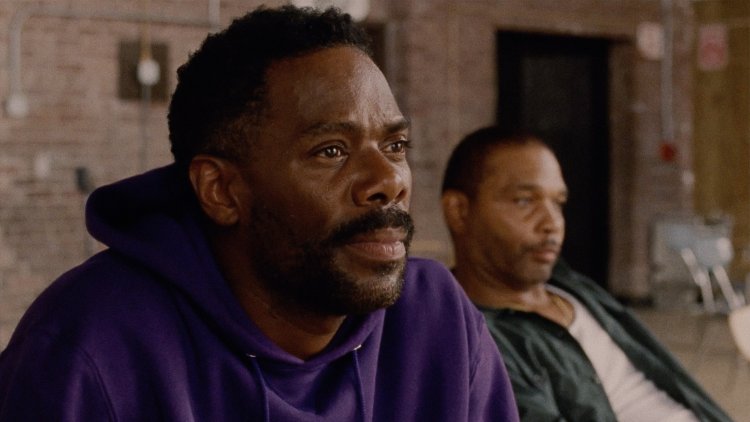A Tender Movie About a Prison Theater Troupe
Based on a real-life rehabilitation program, Sing Sing is an earnest depiction of art as a healing force.

Early in the film Sing Sing, a group of inmates in the titular maximum-security prison gather for a brainstorming session. As members of the Rehabilitation Through the Arts (RTA) program, they have to pick their next play to stage, and one of them has suggested they come up with an original comedy. At first the men hesitate, but they gradually enter into a flow of pitches: One wants cowboys to be involved. Another suggests incorporating ancient Egypt as a setting. A fan of A Nightmare on Elm Street proposes adding the character Freddy Krueger into the mix, because why not? The group generates idea after idea without stopping, each member buoyed by the others’ clear enthusiasm.
[Read: The lifelong learning of lifelong inmates]
Sing Sing is full of scenes like this: moments in which a creative exercise sparks a refreshing camaraderie among the incarcerated men. Based on the real-life program that offers the facility’s inhabitants an outlet in theater and other disciplines, the film is an earnest depiction of art as a healing force. That may not sound like the most surprising or fresh message for a film to deliver—of course art is a profound channel for clarity and connection—but Sing Sing is remarkable for its empathetic approach to every character. It’s a tender look at the act of being vulnerable, a process made exponentially more difficult in a place where a person’s humanity is often extinguished at the door.
Part of the movie’s warmth comes from its casting: Other than a handful of recognizable actors—including Colman Domingo, who plays the aspiring performer and playwright John “Divine G” Whitfield, and Paul Raci, who plays the program’s non-incarcerated writer-director, Brent—the cast consists of RTA alumni. The plot, too, is rooted in reality: Sing Sing portrays the unexpected friendship between Divine G and his fellow inmate Clarence “Divine Eye” Maclin. (Maclin plays a version of himself; the real Whitfield appears in a cameo.) When the movie begins, the two could not be more different. Domingo’s Divine G is known as a soulful RTA veteran who studies Shakespeare and operates as Brent’s informal assistant director; Divine Eye is a feared presence in the prison and a newcomer to the RTA who struggles to articulate his emotions. Slowly, the two bond as they try to mount the troupe’s latest play, Breakin’ the Mummy’s Code—as in the one with cowboys, ancient Egypt, and Freddy Krueger—a show the RTA did actually manage to stage.
[Read: The Black family in the age of mass incarceration]
With so many details pulled directly from history, along with scenes shot inside an intake prison that had housed the RTA alumni featured in Sing Sing, the film often plays like a documentary. The director Greg Kwedar trails the men into their cells and workspaces, catching snippets of their conversations. Sometimes, they reminisce about their life before prison. Other times, they joke about their roles. In these moments, the film avoids the showier histrionics seen in prison dramas in favor of capturing the men’s interiority. The camera moves slowly when it zooms, and close-ups come into focus with the same unhurried precision. Such a languorous pace, soundtracked by a hypnotic score composed by the National’s Bryce Dessner, casts a meditative spell, encouraging the viewer to notice more. Take, for instance, the way Divine G and Divine Eye have decorated their cells: The former has pinned up a list of his goals, including writing novels; the latter has pencil drawings taped onto his walls. The pair share a love for art, even if it’s not obvious to them at first.
Sing Sing falters when the script forces dramatic moments that feel contrived, and some dialogue—such as a character noting how talking about feelings is “something men don’t get to do too often”—comes off as a tad on-the-nose. But Domingo and Maclin anchor the film nicely, both delivering fine-tuned performances that convey why the RTA isn’t merely an extracurricular activity for either of their characters. In Divine G’s case, it’s a lifeline. Convicted of a homicide he did not commit, he’s spent years working with innocence projects and fighting for appeals hearings that get him nowhere; being part of the troupe keeps his hurt from calcifying into self-hatred. For Divine Eye, meanwhile, it’s a portal to expressing himself more honestly. As Hamlet—yes, Hamlet is also a part of Breakin’ the Mummy’s Code—he taps into a side of himself he’d previously buried underneath an intimidating facade.
Perhaps the most striking element of Sing Sing, then, is that the film doesn’t care to explore how unusual the program may seem to outsiders. Instead, it takes the troupe members’ journeys with their newest production seriously, focusing on how much solace they gain in having a space to simply play. “Trust the process,” Brent tells the group again and again, reminding them that they don’t need to let anything else in as they create. Sing Sing immerses its audience in the RTA’s efforts the same way, guiding them gently into a world well worth keeping in the spotlight.
What's Your Reaction?




















